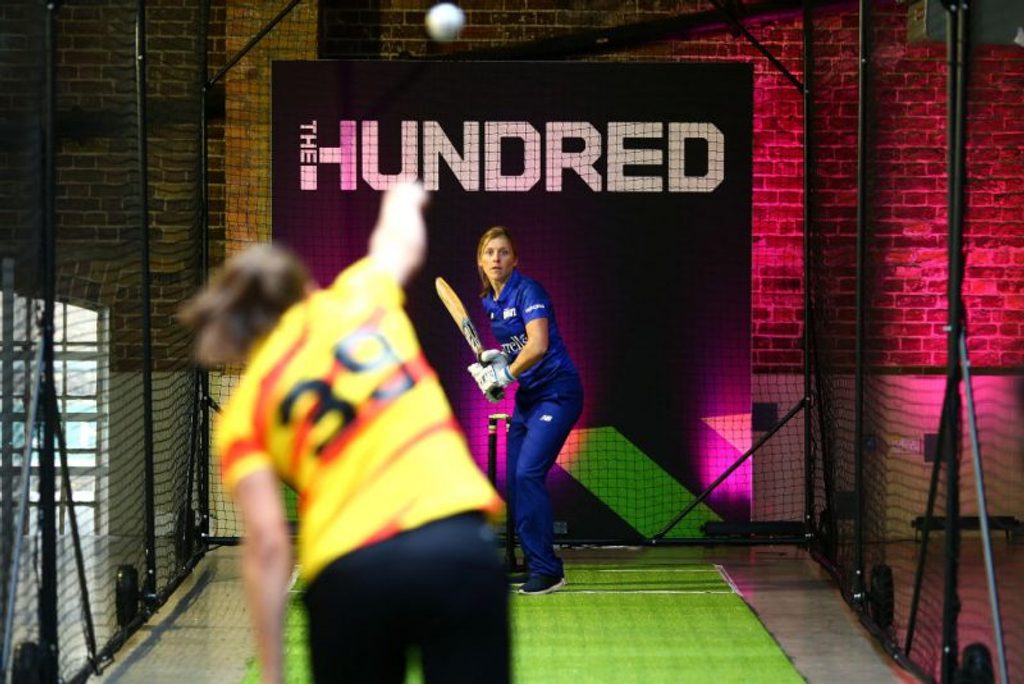
Phil Walker visits an east London warehouse to take in the launch of The Hundred, the most divisive competition in the land.
So here we are. No revoking, no second vote. It’s suddenly got very real. The Hundred is here, and it’s not going anywhere. For many, it remains an act of executive fiat and self-sabotage; for others, it’s a fun-filled shot in the dark. It’s already divided English cricket, and we’re still a year away from a ball hurled in anger.
Nothing says ‘big reveal’ quite like a swirl of hacks, comms teams and kitted-up players huddling in an east London warehouse discussing the finer points of unplayed games. We now know the names of the teams – an uneasy hotchpotch of regions, cities, venues and an actual country – and who’ll be coaching them (though we basically knew those anyway), the host venues for both iterations (men and women), many of the overseas stars who’ll be entered into the ‘Draft’ on October 20, the specifics of the rules, and which gut-busting conflation of salt and glucose will be splashed on which centrally-contracted player’s shirt.
— Wisden (@WisdenCricket) October 3, 2019
Its protracted birth, of course, has been agony to watch at times – a tangle of drip-fed info, bad leaks, and obfuscation, with certain messages, not least relating to kids and mums (some of whom even like cricket anyway!), cringingly conveyed. As one county director of cricket put it to me last summer, “the lack of forethought and decision-making, and the dilly-dallying – it’s just been bizarre”. Well, at least we know what it’s meant to look like. The bigger mystery is what, when it comes around, it will feel like. It remains an almighty gamble, one that cricket’s empire of good intentions can’t afford to see fail.
***
Hence to our warehouse, and its cacophony of coffees, clipboards and low-level angst. It’s a tricky gig for the players at these junkets. The slightest equivocation and it’s plastered all over the platforms by mid-afternoon. Equally, all those happy word clouds – “excitement”, “kids”, “long overdue terrestrial TV exposure” – are easily lampooned. And yet for all that it’s another day on the payroll, the spring in their step doesn’t seem faked.
So we talk to Chris Woakes, desperate to know which overseas players will be joining him at Birmingham Phoenix after the Draft. To Heather Knight, a north London resident, buzzing to be the frontwoman of London Spirit. Sam Curran has already pleaded with his team’s bosses to secure Steve Smith’s signature so he doesn’t have to bowl to him. Only Jofra, fresh off a plane from Barbados, sleeps through the din. A quick look at the names already secured throws up some cheer: for the likes of Dan Lawrence (London Spirit), Tom Banton (Welsh Fire) and Pat Brown (Phoenix), this will have felt like a career-defining moment. For the players, what larks. The top male earners will pocket £125k – chicken feed compared to the IPL, but still sufficient to persuade Gayle, Warner, de Kock et al to put in for the Draft.
 Heather Knight with bat in hand at the launch of the 100-ball competition
Heather Knight with bat in hand at the launch of the 100-ball competition
From Knight’s point of view, regrets at seeing the Kia Super League’s demise are more than offset by the chance to align with a new tournament. And the sizeable discrepancy in tournament earnings between the top men and women? “It’s about being realistic. It’s not about trying to find to get the same as Joe, Ben or Jonny; it’s about fighting to get a reasonable percentage. The fact that the women’s game is very much in its infancy as a professional game means that it’s bound to take a long time to get anywhere near to catching up. But it’s a brilliant time to be a women’s cricketer. For young players, they could now have a brilliant career and potentially not have to do too much when they finish.”
This is truly the time to be alive as a professional cricketer.
***
There’s a great irony to all this upheaval, of course, for it comes in boom time, when T20 Blast attendance figures have surged and both World Cup trophies sit in the ECB’s cabinet. Large swathes of county members are fearful of what’s to come. The questions are many and as yet unanswered. Why mess with something if it’s in good nick anyway? Why sideline the Blast, shrink the 50-over comp and marginalise the Championship when we’re world champions anyway? Why threaten the sanctity of the county structure? And what about the soul of the game?
It’s small wonder that many of the cricket-interested public – the ones who love their clubs and should have been wooed from the start, yet were informed that this tournament’s not really for them – have thus far found little charm in the ECB’s offensive. There is a sense that this is their game, and that somewhere along the line they have been sawn off, cut adrift. The disillusionment is not confected.
 Jofra Archer poses with his Southern Brave kit on at the launch of The Hundred
Jofra Archer poses with his Southern Brave kit on at the launch of The Hundred
So will the most valuable people in English cricket – its active fanbase – come round in the end? Will the lure of the bat and the ball prove too much? It’s a key question, because for sure they’ll be needed, to fill grounds, talk about it, and drum up some passion.
And perhaps this is the ECB’s unspoken gamble. That the fundamental, atavistic thrill of seeing one person hurling a hard rock at another person will transcend all other concerns and reservations, bringing the punters in, slicing through all the weariness that congeals around the news of yet another panacea for the game’s supposedly terrible ills.
***
In the afterglow of a summer like that, it’s easy to forget that this tournament was conceived by a terrified governing body turned radical by its own research. It was in 2014 that the ECB surveyed their game, and were scared witless by what came back. It wasn’t just when they asked a few thousand kids to name 10 sports, and three out of five of them didn’t even reference cricket; or the news that only two per cent of those who had heard of the game classed it as their favourite game; or even by the grimly unforgettable figure of a seven per cent drop-off of active club cricketers in one year. It was a combination of the lot.
All of which made 2017’s £1.1bn TV deal, with its landmark feature of cricket’s return to free-to-air from next year, all the more extraordinary. That deal has always been the ECB’s most powerful bargaining chip: most county bosses looked at the bottom line, crossed their fingers, and came out in pragmatic favour. While no one can yet be sure how clubs’ central revenue streams will be affected by the new landscape, everyone can get with a £1.3m windfall, the figure agreed for every county annually from next season.
Let’s face it. The traditional county structure is perpetually under threat. The Hundred has not created this mottled landscape. It was there already. Last summer, one cash-strapped county CEO described this £1.3m to me as a “lifeline”. A few weeks later I spoke to another chief exec, this time on the more secure end of the 18-team carousel, who had a rather different reading for it. He understands that payment as a blunt message to lowdown clubs that they have four years to sort their situations out. Not so much a ‘lifeline’ then, as a stay of execution.
And it’s around this point that we come up against county cricket’s knottiest problem. Namely the fundamental paradox at the heart of a structure that is built on the one hand on notions of collectivism and shared vision, and on the other, tied into the age-old capitalist sporting model of individualism, divisions, successes, failures, profits, losses and all the rest of it. Up until this point, county cricket has rather beautifully inverted the old sporting adage of ‘survival of the fittest’. But for how much longer? This is professional sport in the 21st century. Growth-obsessed, frenziedly busy, scrapping like mad for a slice of the future. Wither the soul in an east London warehouse.
***
History has shown us that cricket has constantly adapted to survive. Versatility of form is one of its better qualities. For all the gaudiness, this amendment still has the feel of a very English revolution. The pitch is still 22 yards. It’s still 11 v 11. The bats are the same width, the ball the same weight. The quicks are still quick, the hitters gonna hit. Personally I like the format. It’s easy to grasp. Sure, it’s condensed, but not to within an inch of its life. There’s scope for match-swinging interventions. Players now routinely make 50-ball hundreds, so we’ll see a few raised bats. We’ll regularly see 400 runs in a match. The format is the least of its problems. If 20-overs is cricket, then so is a hundred balls.
“There’s this great British scepticism about anything that’s new,” one director of cricket at a big county said to me recently. “We’ve always done it the way we’ve done it, so anything that’s new is automatically a load of rubbish.
“It might be f***ing hopeless. But it might be good.”








